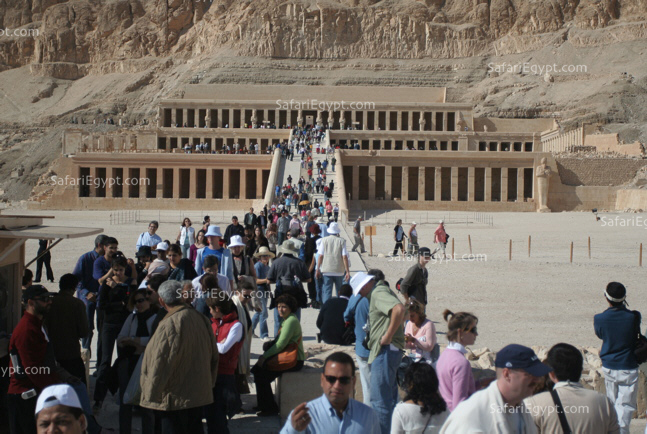Egyptian Queen Hatshepsut: Egypt’s first female Pharaoh
Ancient Egyptian history continues to unfold refined stories to
inspire the modern world, and reinforce the indisputable fact
that it had set unprecedented, civilized models in almost all
aspects of life for the modern world to follow. Hatshepsut’s
story is key, when it comes to learning about women’s status in
ancient history. As in the midst of rigid customary, where no
female was granted the right to rule as a “Pharaoh”, rose
Hatshepsut to challenge all conventions; succeeding to engrave
her name as the first female Pharaoh in recorded history, not
only to create of her time in power a thriving one, but also to
pave the way for other leading female figures such as;
Cleopatra, and Queen Elizabeth to profoundly shape
civilizations, following in her footsteps.

(Hatshepsut Temple, Deir Al Bahri, Egypt)
Historical overview at a glance:
Born in the 15th Century B.C. to royal parents: Tuthmose I, and
Ahmes, Hatshepsut was destined to become the family’s fortunate
daughter, carrying their royal blood; a common norm solely
enjoyed by females in ancient Egypt. Soon after her father’s
death, Hatshepsut’s younger, half brother Tuthmose II was
ascended to throne, however, to claim his position as “Pharaoh”,
he had to keep the royal blood intact, and thus, married his
half sister; Hatshepsut. Shortly, after Tuthmose II had ruled
Egypt, he caught a deadly skin disease, which had not only left
Hatshepsut a widow with two children- a daughter of their own “Neferura”,
and a son “Tuthmosis III” from another wife-, but had also left
her with a matchless responsibility of ruling Egypt, along her
young, nephew’s side. However, the situation didn’t last long,
as Hatshepsut could no longer tolerate the fact of co-ruling,
and with innate, leadership qualities, urging her to challenge
the face of ancient history, she proclaimed herself “Egypt’s
first female Pharaoh” of the 18th Dynasty.
Altering Egyptians’ belief…altering history
To counter Egyptians’ common belief that a Pharaoh should always
be a man, Hatshepsut used her charisma, and intelligence to
manipulate the norms, and invent intertwined strategies to
legitimize her unusual position. She started off by inventing a
co-regency with her royal father Tuthmose I, and magnificent
representations found on
Temple of Queen Hatshepsut at Deir El Bahri in Thebes
live to reveal her sharp intentions, as they read “This daughter
of mine, Hatshepsut – may she live- I have appointed as my
successor upon my throne…she shall direct the people in every
sphere of the palace; it is she indeed who shall lead you”.
Moreover, the common belief system, dominating the Egyptians’
minds at that time was a highly complex, mythological one,
focusing on the importance of Egyptian Gods, and their relation
to the world. Consequently, Hatshepsut’s wit lead her to seek a
“divine” reason, not only to strengthen her legitimacy, but also
to obtain a solid base of support, and acceptance by both the
priests and the people, claiming that the God Amon-Ra; -creator
of the universe, who wears the sun on his brow- spoke to her,
announcing that she is the new King with both Upper and Lower
Egypt as her dear possessions. She also claimed that he granted
her the title Maat-Ka-Ra, which simply means; Goddess of Truth
and Universal balance. With the Kingship world’s gates widely
open for Hatshepsut, she knew that to enter, neither the people,
nor the priests would take her seriously, unless she adopts male
adornments, and so, she was always seen attaching a false beard,
and wearing male clothing, as depicted in all statues we see of
her nowadays, where no one can mistake her for a woman!
continue reading about Queen Hatshepsut (1 -
2)
Next >>
|
|

